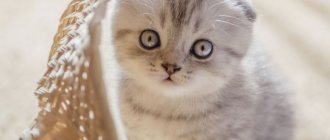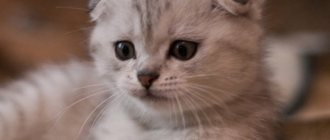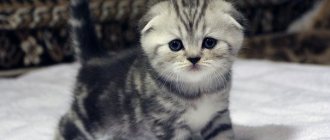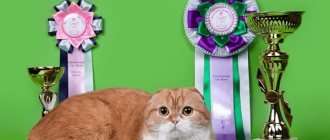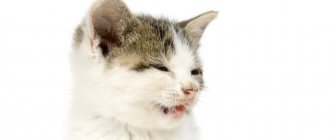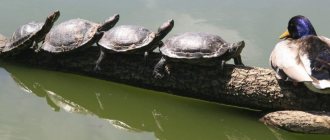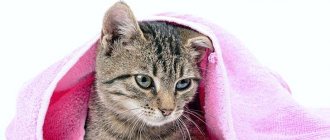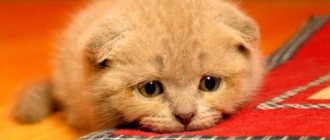Choosing a kitten class
Breeders know that the division into classes is very arbitrary: it only helps determine the baby’s career prospects . Often kittens of the same litter fall into different classes, but this is always the personal point of view of the breeder. In addition, in the process of growth there are transitions from breed to pet, from show to breed and vice versa.
Show class (show – display, demonstration)
This includes kittens that fully comply with the breed standard, without disqualifying characteristics or shortcomings. Reference cats are included in the top show class (top – top, highest). These animals remain in nurseries for breeding and exhibition activities. Show-class kittens (the pride, decoration and advertising of the nursery) are practically not put up for sale. Such copies are sold for a lot of money and with reservations - “on conditions” or “in co-ownership”.
Breed class (breed – tribe)
This group is represented only by cats with excellent pedigrees and excellent reproductive capabilities. They also appear at shows and win titles that give them the right to participate in breeding. With proper selection, show-class offspring are obtained from such females.
This is interesting! Breeding males usually fall into the pet category, since a breeding cat is judged not so much by its pedigree and conformation, but by the health and quality of the kittens it produces.
Such animals are often sold with the condition of mandatory removal of the reproductive organs, which does not prevent them from having a pedigree and claiming exhibition regalia (in the “castrati” category). The price for breed-class cats is in the average price range. It happens that show-class kittens are found among breed-quality animals. This happens due to oversight or due to insufficient experience of the breeder.
Pet class (pet – pet)
These are purebred kittens that, in the opinion of the breeder, are not of interest either for exhibitions or for breeding. They often have disqualifying defects that do not threaten health or life.
Such kittens are sold already neutered or with the condition of spaying. A pedigree for a pet-class animal is issued only at the request of the buyer: in this case, the entry “not for breeding” appears in the documents. The cost of pet quality kittens is the lowest.
Return to content
Periodization of the kitten's life stages. The first stage - mom is nearby
Kittens grow up to 1 year, during which significant changes occur every month. At the same time, 2-2.5 years is the period when the body finally gets stronger and becomes an adult.
| Age | Image | Peculiarities | Recommendations |
| First week | Weight – 100 g. Body length – 9-12 cm. No hearing until the 4th day. Eyes don't open. Undercoat appears. The umbilical cord separates on the 3rd day | Food is mother's milk, which the baby senses through olfactory receptors and consumes naturally. Antibodies contained in cat milk help an unvaccinated kitten resist infections. Do not disturb the unity of the kitten and the cat, so as not to scare the baby | |
| Second week | Weight - 250 g. By the end of this period, the eyes open; at first, the eye color of all kittens is cloudy blue. Attempts to walk, crawl away from the mother by 30-50 cm. | Stroke the kitten gently. Do not cause aggression on the part of the mother cat, who is worried about the younger generation at their first manifestations of independence | |
| Third week | Weight – 300 – 350 g. Support on 4 legs. On days 15-17 they begin to see. Orientation in distances. First milk teeth. Scratching behind the ear. Interest in playing with people | Play with kittens without sudden movements. Do not leave small children and kittens unattended | |
| Fourth week | Weight – 450 g. Approximately 26 teeth | Organize worm prevention. Drink filtered water from shallow bowls. Provide the kitten with constant access to water | |
| Fifth week | The cat reduces the level of care for the baby. The kitten learns to wash itself. The fur becomes brightly colored | Stock up on age-appropriate liquid food. Include solid foods in your diet. Provide the kitten with constant access to food (100 grams of food is the norm). Do not allow your baby to eat from adult bowls. Organize a pet house |
Choosing the gender of the kitten
When thinking about who is more useful on the farm, a cat or a male cat, you should not blindly trust the description of the breed’s character, as well as theses about the greater affection of females and the unsociability of males. In practice, everything may turn out differently, since the disposition of the future pet depends little on its gender, and sometimes even contradicts the breed characteristics.
That is why, when deciding on the gender of the Scottish Fold, proceed from a specific goal . If the breeder's laurels attract you, buy a breed or show-class female. You can, of course, take a breeding cat, but keep in mind that the requirements for males are much higher, and they are somewhat more difficult to maintain.
Important! When buying an elite "Scottish" there is always a certain risk: a maturing kitten may not live up to high expectations and descend into a lower (unsuitable for breeding) class.
It is much easier for those who choose a Scottish Fold solely to enliven family leisure time . In this case, as a rule, the choice falls on the boy. Firstly, castrating an animal is somewhat easier than sterilizing it. Secondly, adult cats (due to their size) look more respectable and more prestigious than female cats.
Return to content
How to choose the best kitten from a litter
Many people take into their home the most “unlucky” kitten that is offered to them, sometimes even with obvious signs of illness. They motivate this by the fact that no one except them will covet the runt, which means the baby will be doomed. Caring for a kitten takes a lot of time and money, and there is no guarantee that the pet will recover. If you are looking for a pet for children, choose a strong, healthy and cheerful kitten.
You can determine whether your baby is healthy without consulting a veterinarian:
- The coat is tangle-free, thick and dry, the skin is free of crusts and dandruff, and free of parasites.
- Clear, wide open eyes with no signs of watery eyes or pus, and the third eyelid is not visible.
- Nose without crusts or discharge.
- The ears are clean inside, without dark brown discharge.
- There are no traces of feces around the anus.
- The tummy is not swollen like a drum, it is soft.
- The kitten does not look emaciated, well-fed and active.
Little kittens are very curious and active. When they are not sleeping, they play almost all the time. If the baby is indifferent to what is happening, this is most likely a sign of illness.
Watch the kitten play with its siblings. If he is aggressive, he will continue to try to dominate. If he is timid and cautious, he can grow up fearful and withdrawn, avoiding communication with people.
A healthy kitten is curious and active
Take the animal you like in your arms. If the baby behaves calmly and friendly, feel free to take it home. If it hisses and scratches desperately, look for another option.
Many people wait for the kitten to come up to its future owner and start playing with him. This is a really good sign. Such a kitten, if properly raised, will grow up to be a sociable, cheerful and friendly cat.
What age is best to take
The kitten is not separated from its healthy mother for at least two months: during this time, it drinks its mother’s milk, rich in antibodies, and strengthens its immunity. Early (at 1 month) separation from a cat is fraught with stress, which negatively affects the health of babies. It is preferable to select a Scottish Fold in the range from 3 to 9 months, in the so-called adolescence. At this time, the “Scots” become long-legged, slightly awkward and stretched out, like all teenagers: against this background, the breed’s shortcomings clearly appear.
If by this age the baby still has large ears, a loose undercoat and a thin tail, do not entertain the illusion that the ears will shrink, the undercoat will grow, and the tail will become shorter and thicker. An exemplary “teenage” Scottish Fold has a thick muzzle, powerful paws, small neat ears, “stuffed” hair and a not particularly long tail.
Return to content
Breed colors
Every country, and especially every nursery, works with its own favorite colors. The number of allowed options is quite large. You can choose either a single-color representative or various patterns and color marks.
Acceptable colors:
- Harlequin. On a pure white background, large markings are allowed on the back and head, the tail must be fully colored, and a different color may appear on the croup. No more than a fifth should be painted. Blue eyes are acceptable.
- Wang. Completely white except for the colored tail and a couple of spots on the head.
- Bicolor. Half of the cat is painted a different color (not white). A white closed collar is required.
- Solid white. Yellow or other shades are undesirable. Kittens are allowed to have colored spots on their heads, which should go away with age.
- Solid black. Any shade on both the coat and the undercoat (brown, ashy), as well as the presence of white hairs, is prohibited.
- Solid purple. A pinkish tint to the coat and nose is preferred.
- Solid blue. All shades are allowed, but light colors are better.
- Solid red (red). Be sure to be smooth and bright. Half rings of a light shade on the paws and a hint of a pattern on the forehead are acceptable.
- Tortoiseshell. One of the most beautiful colors. A perfect mixture of cream, red, blue, black, red and chocolate colors and shades. Preference is given to cats with a red or cream spot on their forehead. The paw pads and nose are painted in two primary colors, which predominate in the color. Kittens are allowed a smoky undercoat. Any drawings are not acceptable.
What documents should there be?
The purebred Scottish Fold cat, as well as its health parameters, must be confirmed by official documents:
- metric or pedigree;
- certificate of registration (for American organizations);
- purchase agreement;
- veterinary passport;
- transfer to own a cat (in rare cases);
- veterinary certificate No. 1 (for imported animals).
Important! A serious nursery will not sell cheap kittens without documents and expensive ones with documents. From a responsible breeder, all animals have documents issued simultaneously for the litter, which is registered as a whole.
If you receive a metric in your hands, the pedigree is no longer needed, and vice versa. But the breeder is obliged to hand over one of these main papers, regardless of the purpose of acquiring the “Scot” - for breeding or castration.
Documentation of the litter in the breed club is strictly regulated, but is inexpensive. All papers received from the breeder minimize your potential risks: you will always return the animal and the money spent if it is found to have congenital anomalies.
Metrics
This is a birth certificate issued after the animal is registered in the club system. The following must be included in the document (where the emblem of the system to which the “Scotsman” is assigned) is affixed:
- Name;
- date of birth;
- gender and breed;
- color;
- names/colors of manufacturers;
- breeder's name and other information.
The European certificate is affixed with the seal of the club and the signature of the responsible person who activated the litter: this is necessary to exchange the metric for the pedigree. In American systems, a slip (metric) is used to register a kitten and obtain a pedigree through the central office.
Pedigree
This includes the kitten’s ancestors (up to 3–5 generations) with their names, colors and pedigree numbers . This document contains the name of the nursery and club, the association's emblem, information about the kitten, as well as the names of the breeder and owner.
Attention! The “owner” column should contain your name, not the name of the breeder. To do this, obtain a pedigree yourself or agree with the breeder to prepare it in advance.
European pedigrees are provided with a number, the seal of the club and the signature of its leader, American pedigrees - only with a number . Pedigree in the USA is informative, and pedigree is confirmed by registering the kitten (and its litter) in the system according to its rules.
In European associations, you may be given a pedigree without a number or marked “pet”, or not at all if you adopted a “Scot” for castration. If you want to draw up a pedigree yourself (provided you have a metric), do it before the pet turns one year old. If you are not going to breed purebred cats, you won't need a pedigree.
Veterinary passport
Information such as:
- name and gender of the kitten;
- breed and date of birth;
- vaccination records (with a veterinary clinic stamp, a special sticker and a doctor’s signature);
- owner/breeder's name.
Despite the fact that a veterinary passport is issued to every purebred animal, it cannot serve as confirmation of the breed: the veterinary passport is filled out by the breeder or doctor, and clubs and felinological associations are responsible for the purity of the breed.
Other documents
All other documents (certificate of registration of the kitten in the system, transfer of ownership, veterinary certificate in form No. 1) are optional, that is, optional. An exception is a purchase and sale agreement, which will protect your rights if an unscrupulous breeder sells you a cat that is known to be sick.
Important! A Scottish Fold cat without documents is not recognized as a purebred cat and is automatically excluded from breeding.
Return to content
Nutrition
In order for food to benefit the cat, you will need to follow some rules. First of all, there should be a balanced diet. As a rule, Scottish cats eat dry, wet food or eat natural food. The food should be of high quality and with a normal dosage of meat.
It is prohibited to mix natural food and feed at one time. It is allowed to give meat products, cereals and vegetables together.
The Scottish Fold cat needs to be given protein food. It is best to feed the animal low-fat meat products, fish, and dairy products.
When a kitten grows up, it must receive all the necessary fats; they are found in egg yolks and butter. The pet should eat on average 2-3 times a day in small portions. It is not recommended to feed a fold-eared cat in large quantities, as overeating can lead to obesity.
Choosing a healthy kitten
More stringent criteria are applied when selecting kittens for breeding. Applicants must be sufficiently mature: if possible, they are purchased in the fall, since the heat makes its own adjustments to the exterior. Some kittens' ears stand up or stand up completely. In this case, decide for yourself whether you definitely need a Scottish fold or whether a Scottish straight will suit you, especially since the latter will also produce babies with rolled-up ears.
When examining the kitten, pay attention to the configuration of the bite - in the Scottish Fold it is scissor-shaped. Cats (unlike dogs) do not have such strict requirements for their teeth: the main thing is that they are complete, intact and even. It happens that the color of an adult “Scotsman” is strikingly different from what was stated when purchasing it.
In order not to be disappointed in your expectations, write this clause in the contract, and choose a kitten together with a person who can give a forecast on the final coat color of a mature pet. The kitten you choose should be healthy and playful, have a thick and uniform coat, without spots or gaps. No dirt in the ears. The eyes should shine, but not from tears or painful discharge. A healthy kitten is always interested in what is happening: lethargy and apathy are excluded.
Return to content
Health and care
On average, representatives of the breed have a good life expectancy and good health. But, as with everything, there are exceptions. Most often, problems arise with folds. In this regard, straights have healthier genes.
In terms of care, Scottish cats are also not very whimsical. They calmly get used to regular brushing. The coat, despite its softness, does not require daily combing, even for long-haired specimens.
Like any cat, the Scotsman must undergo hygiene procedures (teeth, eyes, ears). The latter, in light of physiological characteristics, is a prerequisite.
Scottish fold kitten price
The breed is in demand both in our country and abroad. In Russia, dozens of nurseries are engaged in breeding Scottish fold cats, from the capital to the periphery. “Scots” are bred in Yekaterinburg, Tambov, Ulyanovsk, Tyumen, Yoshkar-Ola, Stavropol, Samara, Tver, Vladimir, Izhevsk, Saratov, Veliky Novgorod, Zelenokumsk, Kostroma and more.
The price for a kitten with a pedigree starts from 8 thousand rubles and reaches 20-25 thousand. On average, purebred babies are put up for sale for 15 thousand rubles. Please also note that the Scottish Fold will cost you a little more than its sibling with straight ears (even if the breeder assigned the same quality class to both of them).
Return to content
Target
If you have never visited or participated in a pet show, you have not even thought about its prospects . However, if you are lucky enough to purchase a Scottish Fold directly at an exhibition, the seller will advise you to take part in such an event at least once. And then, as the owners of such “show” pets usually tell me... Once I tried, I won or didn’t win, but I want to do it again! Exhibitions of elite animals are becoming not just a hobby for people, but a real addiction (of course, in the good sense of the word). Of course, you can exhibit the most ordinary cat of yard breeds, but, you see, it is unlikely to win recognition.
Some owners of Scottish Folds do not always want to show their pets in public - for them it is something personal.
Therefore, before you buy a cat, clearly define the purpose of your purchase, what fate you have prepared for your pet. Last but not least, this is important because by buying a kitten “for yourself” you can save on confirming the pedigree, whereas most elite exhibitions require a supporting document.
Breeders' advice
Breeders are reminded that the Scottish Fold cat can be very different. In one litter, both Scottish Straights (with straight ears) and Scottish Folds (with envelope ears) are born.
Moreover, both varieties can have not short, but semi-long hair. Then they will be called Highland Straights (Scottish Straight Longhair) or Highland Folds (Scottish Fold Longhair).
Lop-eared and straight-eared
Scottish Straights differ from their fold-eared relatives only in the position of their ears, maintaining the indescribable charm of the breed as a whole - they, like Folds, are round-eyed, respectable and charming. Breeding work with the Scottish Fold is full of surprises, since mating occurs exclusively between fold and straight.
This is interesting! Crossbreeding of sires belonging to the same type - Scottish Fold - is prohibited throughout the world. It has been noticed that such matings produce kittens with bone tissue abnormalities.
With a 50/50 probability, a straight-eared cat can also produce fold-eared offspring . In practice, the distribution of straight-eared and fold-eared babies in one litter cannot be planned: sometimes all newborns have envelope ears, sometimes the entire litter is decorated with straight ears.
Short-haired and long-haired
Short-haired animals have a soft, but quite dense coat, reminiscent of plush to the touch. Highlands (with long hair) can be born from both long-haired and short-haired sires (if they have the recessive gene for long hair).
This is interesting! Often, a cat gives birth to completely different kittens, and in one litter there are 4 recognized variations of the breed, with different ear shapes and different coat lengths.
The Highland coat cannot be cottony (this is considered a flaw), but must be silky and airy, not matting and requiring almost no maintenance. The abundant fur of the “Scots” does not spoil, but even more focuses attention on their rounded head and expressive round eyes.
Return to content
Mating of representatives of the Scottish breed
The main thing you should know before breeding “Scottish cats” is that both the female cat and the female cat must not belong to the Scottish Fold variety. The offspring from such a cross will appear with serious pathologies. It is also not recommended to mate with other breeds - the consequences can be very unpredictable.
The cat is ready for pregnancy and childbirth at the age of one and a half years. It is ideal to breed after the female has gone through two heats. The cat should go on a “date” on the third day of estrus. To ensure a guaranteed result, you will need to leave it with the cat for two to three days.
Before mating, both partners must be vaccinated against all possible infections. Two weeks before vaccination it is necessary to carry out deworming. It is advisable that the cat be experienced, especially if this is the female’s first mating. It is also important that the “groom” be larger than the female - he must be able to simultaneously grab her withers with his teeth and reach her rear. If the cat cannot do this, the owner will have to hold the cat by the withers.
